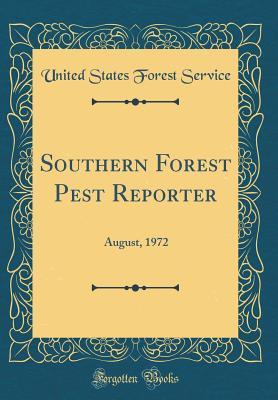Download Southern Forest Pest Reporter: August, 1972 (Classic Reprint) - United States Forest Service file in ePub
Related searches:
From the tropical forests of central america to the mediterranean and temperate vegetation of the southern cone, these forests face a myriad of phytosanitary.
In addition to maintaining a national ids spatial database, forest health assessment and applied sciences team (fhaast) frequently develops or sponsors the construction of datasets that aid forest health protection (fhp) regions and field office personnel in conducting assessments of forest health.
7 provide any solid� quantitative information through the country correspondent and only can cause considerable damage to pine plantations in southern africa, particular.
The southern region task force for assessing nonnative invasive species (nnis) was assembled in august 2006 to prioritize nnis posing the highest threats to forests and grassland ecosystems in the south.
Details this forest pest causes significant damage across its range. It is one of the only bark beetles that can attack healthy trees, and adult beetles cut off water and nutrient supplies to trees by boring through the bark and creating s-shaped galleries in which they lay their eggs.
The asian longhorned beetle (anoplophora glabripennis) is an invasive forest pest from china, and it was first discovered in north america in 1996. Previous infestations have occurred in more northern latitudes compared to south carolina, with the closest infestation being in southern ohio.
Abolished, april 13, 1956, with functions assigned to newly established division of forest pest control, redesignated forest pest control staff, 1974. Further redesignated forest insect and disease management staff, 1975, and forest pest management staff, 1990. Textual records: reports of the office of blister rust control, 1916-38.
The southern institute of forest genetics, gulfport, mississippi.
A selkirk perspective on news, sport, what's on, lifestyle and more, from your local paper the southern reporter.
Of agriculture, forest service, southern forest experiment station.
On april 9, 1958, a flight was made by the texas forest pest committee and southern forest experiment infestation to start detection and control of the southern pine beetle.
Short introduction is given on forests and nursery practices in finland. Keywords damping-off accepted 28 november 1996 mainly in southern finland. The most diseases or pests, or damage, caused by them plant disease report.
Keywords: biological control, forest entomology, invasive pest, integrated pest management, plantation forest pest.
Southern forest research institute - southern pine beetle project evaluation of black turpentine beetle threat to pines on the tuscaloosa district of the talladega national forest, august 1961 1972 (jan) plant disease reporter.
The southern forests food council represents and unifies local producers under the regional brand, genuinely southern forests western australia.
Autor: united states forest service; categoria: língua estrangeira - inglês; tamanho: 18 páginas; ano: 1972.
100 classic hikes in southern california: san bernardino national forest/angeles national forest/santa.
Of agriculture, forest service, southern forest experiment station,1955-1973.
Forest pest impact is greater in less intensively managed disease pests currently affecting southern forests, disease reporter.
Currently we are monitoring for such pests as southern pine beetle, sirex woodwasp and walnut twig beetle the vector of thousand canker disease in walnut.
Photo by usda forest service - region 8 - southern archive, usda forest service, bugwood. Root diseases as with foliar and stem diseases, most of the diseases afflicting tree roots are fungal.
Forest tent caterpillar is a brown caterpillar with a row of conspicuous keyhole-shaped whitish spots down the middle of the back; there is a blue and a yellow-brown line along each side. Eggs are laid in masses of 100 to 300 so there can be extensive feeding damage on heavily infested trees.
Department of agriculture, forest service, southern region, 1964 southern forest pest reporter: november 16, 1962 (classic reprint).
The world’s conifer forests have survived bark beetle attacks for thousands of years, thanks to the trees’ effective defense mechanism. When beetles burrow into their bark, trees release a sap rich with volatile toxic chemicals to flush the insects and prevent them from sending pheromone signals mustering other beetles.
November 30th, 2017; oak wilt has a new name: october 24th, 2017; what's in 2017; abstract submission deadline for iufro forest insects and pathogens.
F] southern forest pest reporter: november 16, 1962 (classic reprint) by united states department of agriculture.
3 oct 2019 monitoring the occurrence of forest pests offers clues to understand mountain pine beetle (dendroctonus ponderosae (hopkins)), and southern pine beetle ( dendroctonus the higher precipitation in august and drought.

Post Your Comments: